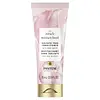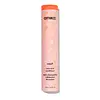What's inside
What's inside
 Benefits
Benefits

 Concerns
Concerns

 Ingredients Side-by-side
Ingredients Side-by-side

Water
Skin ConditioningStearyl Alcohol
EmollientCetyl Alcohol
EmollientStearamidopropyl Dimethylamine
EmulsifyingBis-Aminopropyl Dimethicone
Parfum
MaskingBenzyl Alcohol
PerfumingDicetyldimonium Chloride
EmulsifyingGlutamic Acid
HumectantPEG-2m
Emulsion StabilisingDisodium EDTA
Panthenol
Skin ConditioningPanthenyl Ethyl Ether
Histidine
HumectantRosa Gallica Flower Extract
AstringentMethylchloroisothiazolinone
PreservativeMethylisothiazolinone
PreservativeWater, Stearyl Alcohol, Cetyl Alcohol, Stearamidopropyl Dimethylamine, Bis-Aminopropyl Dimethicone, Parfum, Benzyl Alcohol, Dicetyldimonium Chloride, Glutamic Acid, PEG-2m, Disodium EDTA, Panthenol, Panthenyl Ethyl Ether, Histidine, Rosa Gallica Flower Extract, Methylchloroisothiazolinone, Methylisothiazolinone
Water
Skin ConditioningCetearyl Alcohol
EmollientGlycerin
HumectantOlea Europaea Fruit Oil
MaskingDicetyldimonium Chloride
EmulsifyingBehentrimonium Methosulfate
Parfum
MaskingDivinyldimethicone/Dimethicone Copolymer
Hippophae Rhamnoides Seed Oil
Skin ProtectingGlycine Soja Oil
EmollientGlycine
BufferingAlanine
MaskingArginine
MaskingAspartic Acid
MaskingHistidine
HumectantIsoleucine
Skin ConditioningPhenylalanine
MaskingProline
Skin ConditioningSerine
MaskingThreonine
Valine
MaskingCetrimonium Chloride
AntimicrobialStearamidopropyl Dimethylamine
EmulsifyingPolyquaternium-37
Guar Hydroxypropyltrimonium Chloride
Skin ConditioningPhenoxyethanol
PreservativeSodium PCA
HumectantSodium Lactate
BufferingIsopropyl Alcohol
SolventPropylene Glycol Dicaprylate/Dicaprate
EmollientCaprylyl Glycol
EmollientPCA
HumectantCitric Acid
BufferingEthylhexylglycerin
Skin ConditioningPPG-1 Trideceth-6
Skin ConditioningHexylene Glycol
EmulsifyingC12-13 Pareth-3
EmulsifyingC12-13 Pareth-23
CleansingDisodium EDTA
Benzophenone-4
UV AbsorberButylphenyl Methylpropional
PerfumingHydroxycitronellal
PerfumingHydroxyisohexyl 3-Cyclohexene Carboxaldehyde
MaskingLimonene
PerfumingWater, Cetearyl Alcohol, Glycerin, Olea Europaea Fruit Oil, Dicetyldimonium Chloride, Behentrimonium Methosulfate, Parfum, Divinyldimethicone/Dimethicone Copolymer, Hippophae Rhamnoides Seed Oil, Glycine Soja Oil, Glycine, Alanine, Arginine, Aspartic Acid, Histidine, Isoleucine, Phenylalanine, Proline, Serine, Threonine, Valine, Cetrimonium Chloride, Stearamidopropyl Dimethylamine, Polyquaternium-37, Guar Hydroxypropyltrimonium Chloride, Phenoxyethanol, Sodium PCA, Sodium Lactate, Isopropyl Alcohol, Propylene Glycol Dicaprylate/Dicaprate, Caprylyl Glycol, PCA, Citric Acid, Ethylhexylglycerin, PPG-1 Trideceth-6, Hexylene Glycol, C12-13 Pareth-3, C12-13 Pareth-23, Disodium EDTA, Benzophenone-4, Butylphenyl Methylpropional, Hydroxycitronellal, Hydroxyisohexyl 3-Cyclohexene Carboxaldehyde, Limonene
 Reviews
Reviews

Ingredients Explained
These ingredients are found in both products.
Ingredients higher up in an ingredient list are typically present in a larger amount.
We don't have a description for Dicetyldimonium Chloride yet.
Disodium EDTA plays a role in making products more stable by aiding other preservatives.
It is a chelating agent, meaning it neutralizes metal ions that may be found in a product.
Disodium EDTA is a salt of edetic acid and is found to be safe in cosmetic ingredients.
Learn more about Disodium EDTAHistidine is a semi-essential amino acid used by our bodies to create protein. It has humectant and skin conditioning properties.
Our bodies use histidine to create filaggrin - filaggrin is a structural protein that the skin uses in maintaining skin barrier.
One study found histidine and carnosine to be a dynamic duo for your skin:
Oral histidine has also been found to help with filaggrin-deficit skin disorders such as atopic dermatitis.
Why is it considered a semi-essential amino acid? This is because adults are able to create it but children must get it from their diet.
Learn more about HistidineParfum is a catch-all term for an ingredient or more that is used to give a scent to products.
Also called "fragrance", this ingredient can be a blend of hundreds of chemicals or plant oils. This means every product with "fragrance" or "parfum" in the ingredients list is a different mixture.
For instance, Habanolide is a proprietary trade name for a specific aroma chemical. When used as a fragrance ingredient in cosmetics, most aroma chemicals fall under the broad labeling category of “FRAGRANCE” or “PARFUM” according to EU and US regulations.
The term 'parfum' or 'fragrance' is not regulated in many countries. In many cases, it is up to the brand to define this term.
For instance, many brands choose to label themselves as "fragrance-free" because they are not using synthetic fragrances. However, their products may still contain ingredients such as essential oils that are considered a fragrance by INCI standards.
One example is Calendula flower extract. Calendula is an essential oil that still imparts a scent or 'fragrance'.
Depending on the blend, the ingredients in the mixture can cause allergies and sensitivities on the skin. Some ingredients that are known EU allergens include linalool and citronellol.
Parfum can also be used to mask or cover an unpleasant scent.
The bottom line is: not all fragrances/parfum/ingredients are created equally. If you are worried about fragrances, we recommend taking a closer look at an ingredient. And of course, we always recommend speaking with a professional.
Learn more about ParfumWe don't have a description for Stearamidopropyl Dimethylamine yet.
Water. It's the most common cosmetic ingredient of all. You'll usually see it at the top of ingredient lists, meaning that it makes up the largest part of the product.
So why is it so popular? Water most often acts as a solvent - this means that it helps dissolve other ingredients into the formulation.
You'll also recognize water as that liquid we all need to stay alive. If you see this, drink a glass of water. Stay hydrated!
Learn more about Water